Museum of Natural History
 Because he worked last Sunday, Russ took today off from work. With all this free time, we decided to go on a little adventure to NYC. We've been wanting to visit the Hayden Planetarium for a while, and this was the perfect opportunity. It's convenient that the planetarium is attached to the Museum of Natural History, so we had plenty to do and see after finishing the space show.
Because he worked last Sunday, Russ took today off from work. With all this free time, we decided to go on a little adventure to NYC. We've been wanting to visit the Hayden Planetarium for a while, and this was the perfect opportunity. It's convenient that the planetarium is attached to the Museum of Natural History, so we had plenty to do and see after finishing the space show.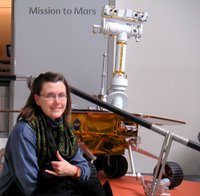 When we got to the museum, we had about an hour's wait before the space show began. To kill some time, we wandered around to the different exhibits, one of our favorites being this model of the Mars rovers Spirit and Opportunity. It's pretty amazing they are both still operational after exploring the Martian landscape for more than a year now! We also weighed ourselves on some different planets, the sun and I think one or two other celestial objects. On Mercury, I only weight 26 pounds. Or was it the Moon? I can't remember...
When we got to the museum, we had about an hour's wait before the space show began. To kill some time, we wandered around to the different exhibits, one of our favorites being this model of the Mars rovers Spirit and Opportunity. It's pretty amazing they are both still operational after exploring the Martian landscape for more than a year now! We also weighed ourselves on some different planets, the sun and I think one or two other celestial objects. On Mercury, I only weight 26 pounds. Or was it the Moon? I can't remember...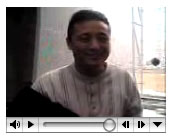 Although I've been to the Hayden Planetarium before, this was the first time I've ever seen the space show. I kind of have mixed feelings about it. On the one hand, there really wasn't much to it - definitely geared towards the lowest common denominator as far as the material it covered is concerned. But the night sky they created inside the giant sphere was beautiful, with an incredible amount of stars. It reminded me of when I visited Moloka`i with Rebecca last summer. The first night, I couldn't sleep, so at 1:30 a.m. I took a little walk down to the beach. The sky was clear and absolutely amazing with the cloudy band of the Milky Way right overhead, extending down to the island of Lana`i. The only reason the planetarium's display of stars looked better was because there were no annoying hotel lights impeding my night vision. To hear Russ's comments on the Hayden Planetarium space show, click on his face. :)
Although I've been to the Hayden Planetarium before, this was the first time I've ever seen the space show. I kind of have mixed feelings about it. On the one hand, there really wasn't much to it - definitely geared towards the lowest common denominator as far as the material it covered is concerned. But the night sky they created inside the giant sphere was beautiful, with an incredible amount of stars. It reminded me of when I visited Moloka`i with Rebecca last summer. The first night, I couldn't sleep, so at 1:30 a.m. I took a little walk down to the beach. The sky was clear and absolutely amazing with the cloudy band of the Milky Way right overhead, extending down to the island of Lana`i. The only reason the planetarium's display of stars looked better was because there were no annoying hotel lights impeding my night vision. To hear Russ's comments on the Hayden Planetarium space show, click on his face. :) At the conclusion of the space show, the planetarium staff let us out of the sphere, which leaves you on a mezzanine level where you can walk around the sphere and look at displays that illustrate size comparisons that begin with the size of the entire known universe all the way down to quarks. In this picture, if the Hayden sphere (the grid in the background is but a small portion of it) represents the size of the sun, then the relative size of Jupiter and Saturn would be that of their respective models hanging high above Russ's head.
At the conclusion of the space show, the planetarium staff let us out of the sphere, which leaves you on a mezzanine level where you can walk around the sphere and look at displays that illustrate size comparisons that begin with the size of the entire known universe all the way down to quarks. In this picture, if the Hayden sphere (the grid in the background is but a small portion of it) represents the size of the sun, then the relative size of Jupiter and Saturn would be that of their respective models hanging high above Russ's head. Near the other end of the size spectrum, if the Hayden sphere represents the size of a Rhinovirus, then this black and white bulbous thingy would the be relative size of a fart... er... methane molecule! (At least I think that was the comparison... sorry can't remember exactly... maybe should have taken notes!)
Near the other end of the size spectrum, if the Hayden sphere represents the size of a Rhinovirus, then this black and white bulbous thingy would the be relative size of a fart... er... methane molecule! (At least I think that was the comparison... sorry can't remember exactly... maybe should have taken notes!) After finishing the size comparisons floor, we watched the little movie they play in the bottom half of the sphere about the Big Bang. When that's over, they let you out into the ramp that spirals around the sphere to the ground floor. All along the spiral, they have a timeline that shows major developmental cosmic events, starting 13 billion years ago to the present. At about 8 billion years ago, we got hungry, so we stepped up our time traveling pace and found our way to the food court.
After finishing the size comparisons floor, we watched the little movie they play in the bottom half of the sphere about the Big Bang. When that's over, they let you out into the ramp that spirals around the sphere to the ground floor. All along the spiral, they have a timeline that shows major developmental cosmic events, starting 13 billion years ago to the present. At about 8 billion years ago, we got hungry, so we stepped up our time traveling pace and found our way to the food court. Yes, we - well, I - was too lazy to leave the museum to find better food. Surprisingly, the food was not as expensive as we expected, but still expensive. And all junk I might add! Don't get me wrong, it tasted ok, just was not very good for us. :)
Yes, we - well, I - was too lazy to leave the museum to find better food. Surprisingly, the food was not as expensive as we expected, but still expensive. And all junk I might add! Don't get me wrong, it tasted ok, just was not very good for us. :) As I'm sure you can imagine, the Museum of Natural History is just way too big to take in all in one day. So we decided that the parts we wanted to see the most were the mineral sections and the dinosaurs. We also managed to take in the biodiversity section and I guess it was mammals of the northern hemisphere or something like that. Oh, and the fishie section too! That's where I met my friend Puff (I named him that, not the museum). He's not a good fish to eat, because the poison inside him would kill you. As you can see, Puff and I played together with Photoshop for a little while.
As I'm sure you can imagine, the Museum of Natural History is just way too big to take in all in one day. So we decided that the parts we wanted to see the most were the mineral sections and the dinosaurs. We also managed to take in the biodiversity section and I guess it was mammals of the northern hemisphere or something like that. Oh, and the fishie section too! That's where I met my friend Puff (I named him that, not the museum). He's not a good fish to eat, because the poison inside him would kill you. As you can see, Puff and I played together with Photoshop for a little while. We found this example of opal in the mineral section of the museum (another photo you can tell I doctored up a bit). I didn't notice till I was doctoring it up that it almost looks as if someone etched a picture of a person doing Tai Chi into the rock. Oh c'mon, use your imagination! :P
We found this example of opal in the mineral section of the museum (another photo you can tell I doctored up a bit). I didn't notice till I was doctoring it up that it almost looks as if someone etched a picture of a person doing Tai Chi into the rock. Oh c'mon, use your imagination! :P
This picture here is proof that Russ and I were at the museum together!
We were trying to get a photo of us together with the head of the triceratops in the background, but I guess our plan didn't really work out. But at least you almost can't tell that I'm the one holding the camera. :D Because our first triceratops picture didn't work out, Russ took a picture of me posing with it. I was trying to give triceratops bunny ears, but instead it looks more like I'm trying to pick his nose. Incidentally, scientists now think that triceratops had those three horns less for protection against predators, and more as anchors to support muscles used for chewing. Whatever the reason for the horns, triceratops was one of my favorite dionsaurs when I was a little kid.
Because our first triceratops picture didn't work out, Russ took a picture of me posing with it. I was trying to give triceratops bunny ears, but instead it looks more like I'm trying to pick his nose. Incidentally, scientists now think that triceratops had those three horns less for protection against predators, and more as anchors to support muscles used for chewing. Whatever the reason for the horns, triceratops was one of my favorite dionsaurs when I was a little kid.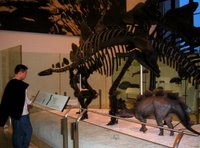 And here's Russ, reading about my other favorite dinosaur - Steggy! I like how the Museum of Natural History displays a model of the whole dinosaur alongside its skeleton, posed in the same manner. Although there are some exhibits, like the stegosaurus one, where scientists have two differnt theories about how a particular dinosaur would stand, so they use the skeleton and the model to demonstrate both positions.
And here's Russ, reading about my other favorite dinosaur - Steggy! I like how the Museum of Natural History displays a model of the whole dinosaur alongside its skeleton, posed in the same manner. Although there are some exhibits, like the stegosaurus one, where scientists have two differnt theories about how a particular dinosaur would stand, so they use the skeleton and the model to demonstrate both positions.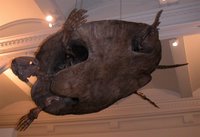 And probably the most amazing thing I learned at the Museum of Natural History is that in way way way way way way way way way way way-back time, there were flying turtles! Just look at this guy! I swear he was at least 20 - 25 feet off the ground! Who wouldda thunk? ;)
And probably the most amazing thing I learned at the Museum of Natural History is that in way way way way way way way way way way way-back time, there were flying turtles! Just look at this guy! I swear he was at least 20 - 25 feet off the ground! Who wouldda thunk? ;)
The dinosaurs and the ancient sea critters were the last of the very many exhibits we went to see today. Tired, feet hurting, and heads full of all kinds of groovy information that we are (well at least I am) unlikely to retain, we made our way out of the museum, saving its other great halls of natural history for another visit. Natural history as well as human history... somebody please tell me why there are whole halls of African and Asian (and probably other) cultural artifacts in the Museum of Natural History when they seem like they belong in a different museum? Not that I really care... just wondering if this is born of some PC-ness?
Anyway... The End!

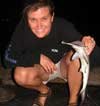
No comments:
Post a Comment